System Preferences in macOS, Sierra: Keyboard (Revised 6 Nov and 1 Dec - changes from 12.1 update and 2016 MacBook Pro)

eXtensions - Thursday 1 December 2016
|
System Preferences in macOS, Sierra: Keyboard (Revised 6 Nov and 1 Dec - changes from 12.1 update and 2016 MacBook Pro) |
 |
|
|
By Graham K. Rogers
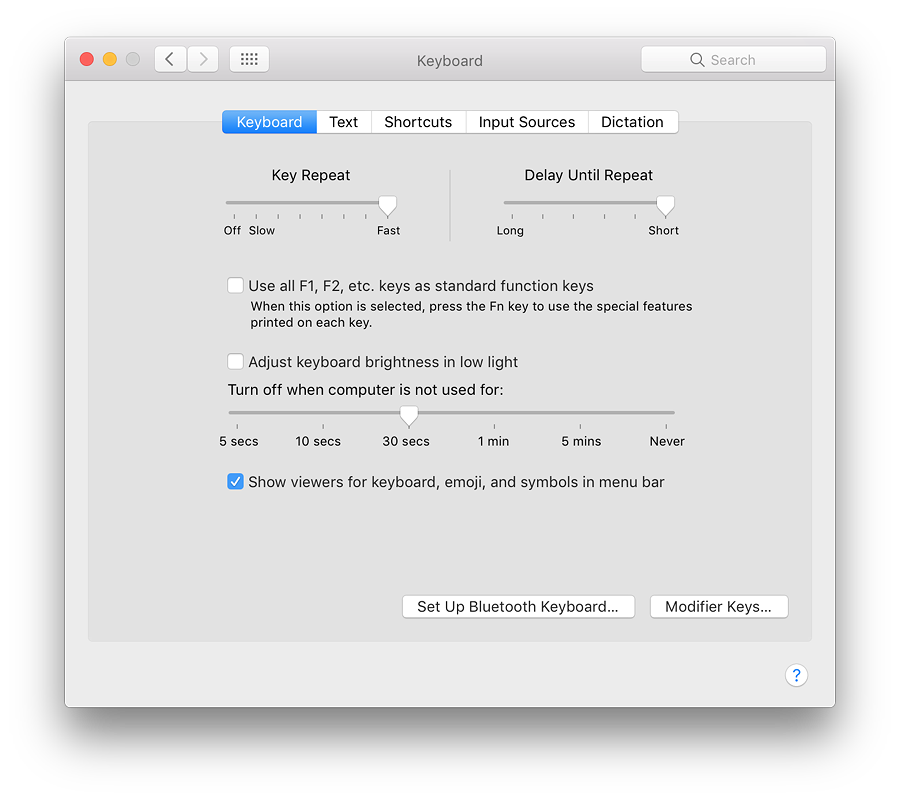
Keyboard Preferences on 2013 MacBook Pro
KeyboardFor those Macs with the Touch Bar, see Keyboard 2 below.The top of the Keyboard panel displays two sliding scales: "Key Repeat" and "Delay Until Repeat". The first shows a scale from Slow - Fast, with Off at the left. This adjusts the length of time between a character being repeated as a key is held down. Since the 10.8 update, key repeating has not been available on my MacBook Pro for characters or numbers. Punctuation and other marks do repeat: for example 2 does not, while @@@@@@@@@@@@ does. This is the same for Thai characters. On the same 2 key, when Thai is active, the / key repeats, while the Thai character for 1 does not. Other keys (punctuation, character/numeric) are likewise affected. The delete key does repeat. The Delay Until Repeat slider adjusts the time before the first repeat begins. The delay may be adjusted between short and long. Below the sliders is a check-box to turn On (or Off) the use of F keys as standard function keys. When active the Fn key must be pressed to use the function key for its additional purpose. This then allows the F key to have a second use (some may already be used), which can be allocated in the Keyboard Shortcuts section. An example might be the F12 key which is marked with the speaker symbol and increases sound volume. When the checkbox is used, pressing the F12 key reveals Dashboard. When the Fn key is pressed with F12, the volume is increased. If the box in the Keyboard panel is not checked, F12 adjusts volume; used with Fn it opens Dashboard. Care should be taken when selecting this. Users should make sure they are aware of what pressing a Function key will do.
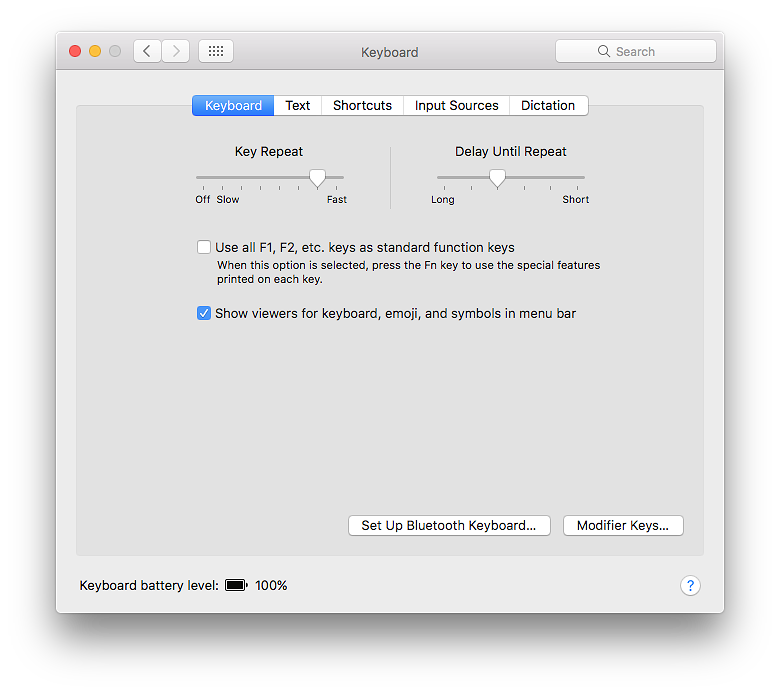
Keyboard Preferences on Mac Mini
There is a final checkbox: Show Keyboard & Character Viewers in menu bar. This uses the same menubar item as for selecting different language keyboards (see Input Sources, below).
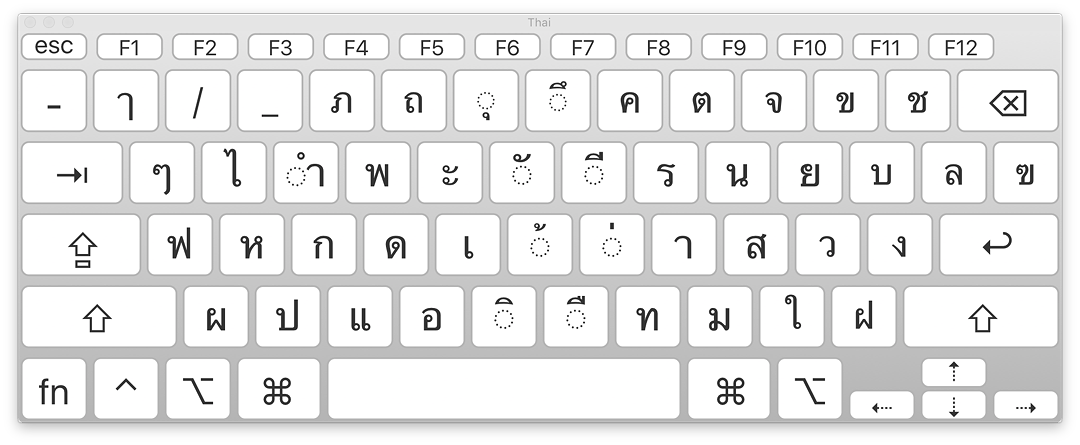
Keyboard Viewer Display - MacBook Pro - Thai Keyboard Selected
A Modifier Keys button at the bottom left allows a user to re-allocate the uses of certain keys. This was changed with the update to macOS 12.1 to accommodate the new MacBook Pro with the Touch Bar which has no ESC key. The panel shown when this button is pressed now shows: Caps Lock, Control, Option, Command, Escape and "No action". For example, the Caps lock key can be changed to operate as the Option key. The panel also has a Restore Defaults button. Great care should be exercised if such changes are considered.
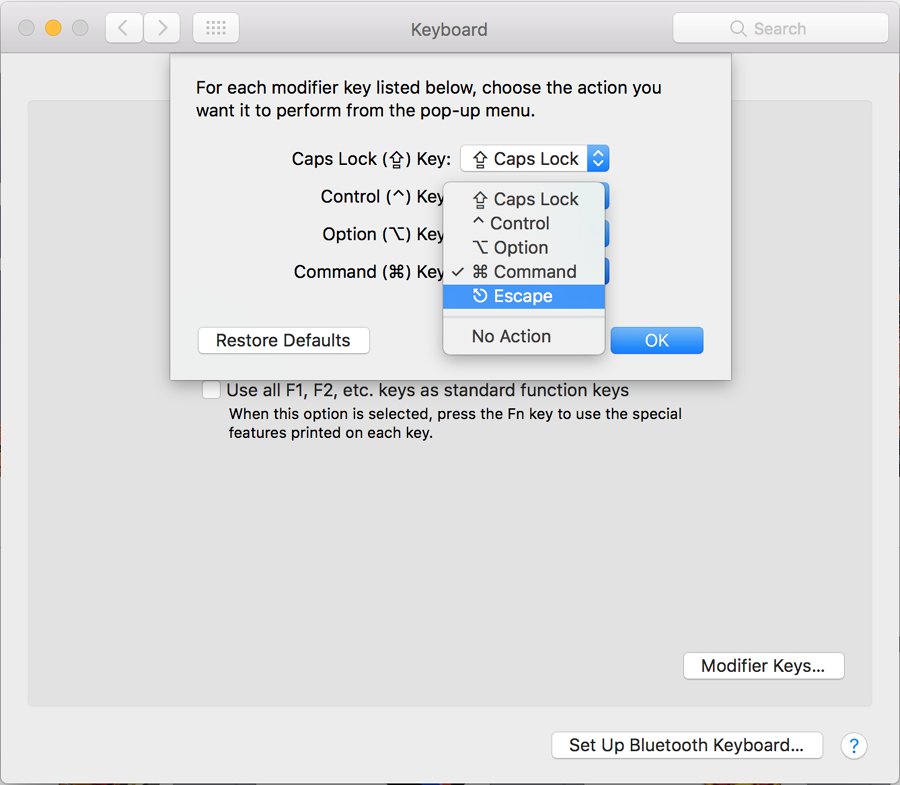
Keyboard 2The arrival of the 2016 MacBook Pro saw several changes to the keyboard layout, with the removal of Function keys and their replacement with the Touch Bar. Reference to those older-type keys was removed and lower down the panel there are controls for the Touch Bar.The top of the Keyboard panel displays two sliding scales: "Key Repeat" and "Delay Until Repeat". The first shows a scale from Slow - Fast, with Off at the left. This adjusts the length of time between a character being repeated as a key is held down. Since the 10.8 update, key repeating has not been available on my MacBook Pro for characters or numbers. Punctuation and other marks do repeat: for example 2 does not, while @@@@@@@@@@@@ does. This is the same for Thai characters. On the same 2 key, when Thai is active, the / key repeats, while the Thai character for 1 does not. Other keys (punctuation, character/numeric) are likewise affected. The delete key does repeat. The Delay Until Repeat slider adjusts the time before the first repeat begins. The delay may be adjusted between short and long.
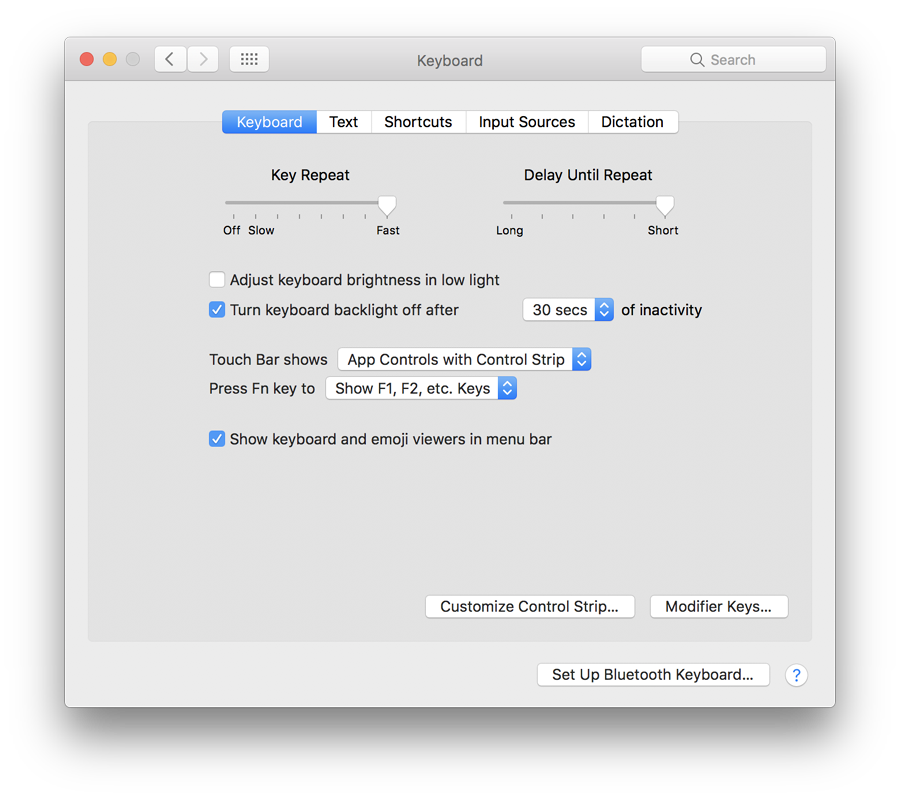
Keyboard Preferences on 2016 MacBook Pro
A second checkbox is marked "Turn keyboard backlight off after" . . . A button alongside has a selection of times from 5 seconds to 1 minute and 5 minutes. Two extended buttons below control the Touch Bar display:
A final checkbox is marked, Show keyboard and emoji viewers in menu bar.
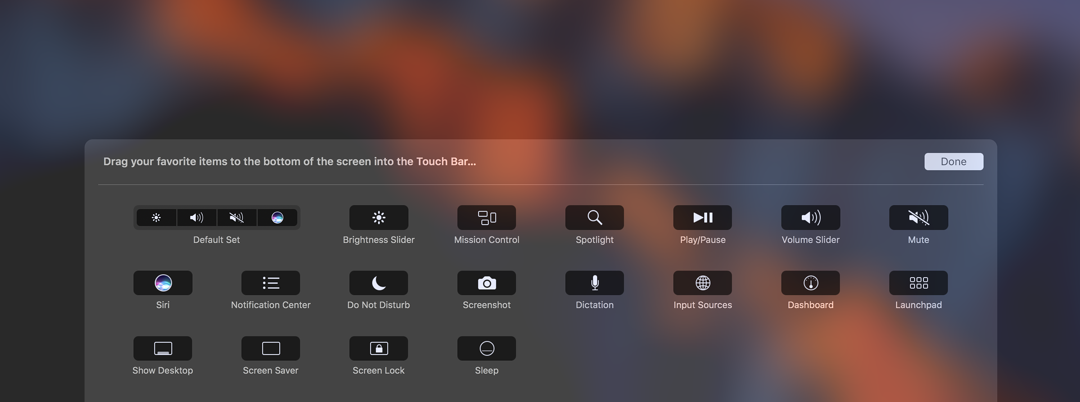
The Modifier Keys button allows a user to re-allocate the uses of certain keys. This was changed with the update to macOS 12.1 to accommodate the new MacBook Pro with the Touch Bar which has no ESC key. The panel shown when this button is pressed now shows: Caps Lock, Control, Option, Command, Escape and "No action". For example, the Caps lock key can be changed to operate as the Option key. The panel also has a Restore Defaults button. Great care should be exercised if such changes are considered.

TextThe panel marked Text helps users when typing. This was previously found in the Language & Text preferences panel (Now see Language & Region). The main section already has some shortcut methods but seems to be much simplified compared with before.The panel to the left contains shortcuts for typing, but should not be confused with the Shortcuts panel (see below). Previously the copyright symbol was included in a text when the user typed (c). There are no such symbols included now. However, by using the Character Viewer, a symbol may be dragged into the "With" column and I was able to add this once again. However, such symbols do not appear to work in all applications, although are available for Messages.
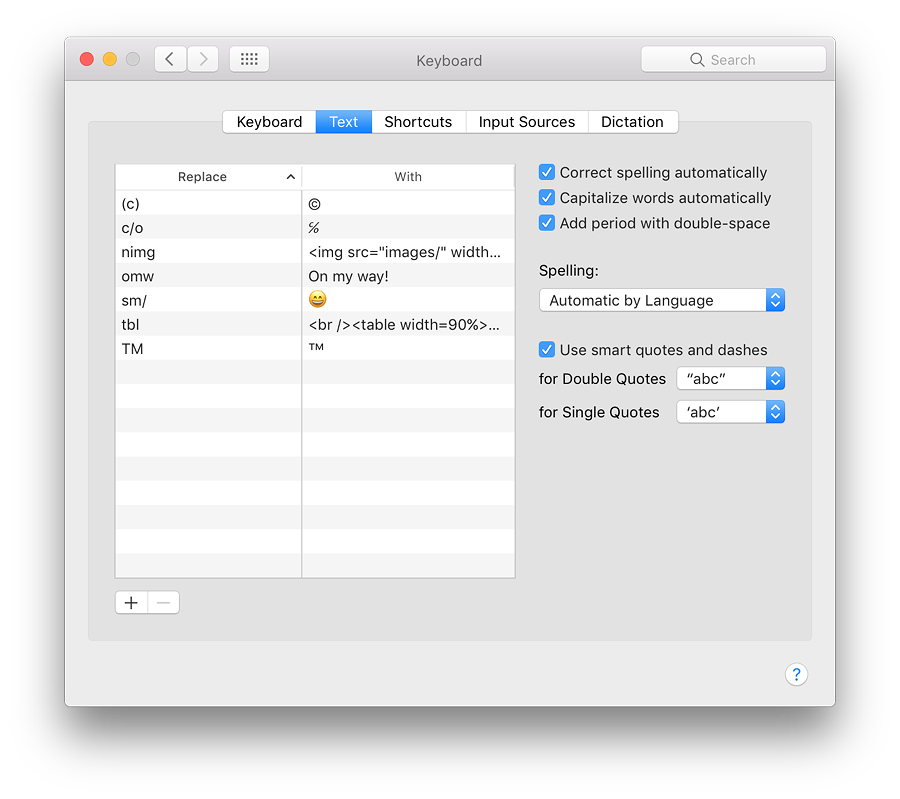
With shortcuts I can avoid much tedious and repetitive typing, while avoiding mistakes. Such a feature from Apple is all very well, but in a perfect world users do not work all day long in Apple-developed applications. None of these shortcuts will work in some of the 3rd party software I use: these commands will only work with applications written in Objective C. I use the utility yType from Plum Amazing to do this (recommended). This is apparently no longer available in the Mac App Store. It does work in all the writing applications I use. Plum Amazing also have a shortcuts app called iKey ($29.99, 1050 baht) available on the Mac App Store.
As with some other features in the Keyboard preferences, this may not be available with some older third party applications (some will work). Like line-breaks, different languages have their own ways to use quotations. A checkbox activates the two buttons available to select the user's preference: with double ("") and single ('') speech marks.
ShortcutsThis section was in the Keyboard Preferences previously where it was called Keyboard Shortcuts. Now the shorter title is used, but this should not be confused with the text shortcuts in the Keyboards > Text panel.Longtime Mac users are aware that using the keyboard is much faster than using a mouse or trackpad. I have written on this a number of times for example in a three-part article: (1) Outline and Applications; (2) Startup keys and Some Suggestions for Their Use; and (3) More Startup keys and Suggestions for Use. The panel for Shortcuts is in two parts: on the left, the area or group that is being controlled. On the right, the commands themselves.
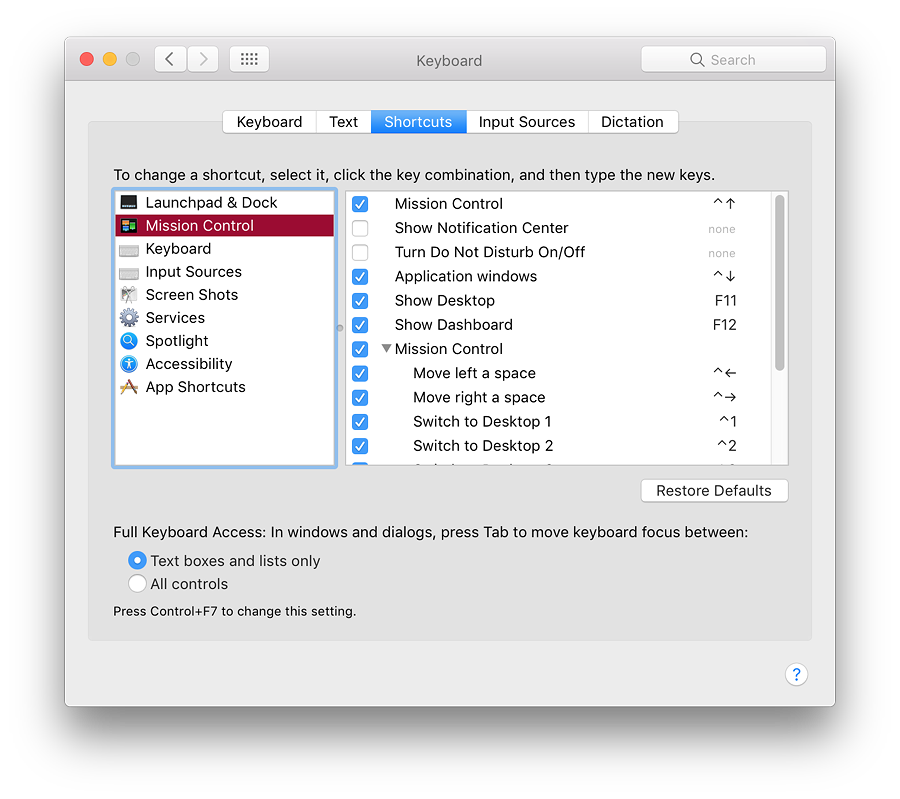
When one of these sections is highlighted, the panel on the right lists all commands for that specific group. Some have fewer than others. For example, Launchpad & Dock has only two listed like Input Sources. Screen Shots has only four. Services has many more. It is only possible to add commands to the App Shortcuts section (also see Services, below). Each key command has a checkbox to its left (active/inactive) and any assigned key command. If the checkbox to the left is not checked, the key combination is greyed out or shows, "none". Clicking on this brings up a box that allows a key combination to be added or changed. To add or change a shortcut, we may double-click over the key command shown. This reveals a small box in which the new key combination can be typed. If there is a conflict (the combination is already being used), yellow warning triangles appear: beside the command, under the panel, beside the current section and beside the section which is using the keys. By default in OS X, Command + Space opens a Spotlight search. For many years I have used this combination to switch keyboards. I prefer to keep it that way. To use the keyboard switcher keys, I entered the combination (now in Input Sources) and deactivated the Spotlight command. This now has its own specific section and a different key command on my computer (F1 or Fn F1).
When viewed in the Keyboard > Shortcuts panel, most Services commands do not have a key combination allocated. By highlighting the command, a small button marked "add shortcut" appears. Clicking on that opens a text box in which a key combination can be entered. This will be useful for those who have a specific task that is repeated often. However, when I entered a key command which I knew would conflict, the yellow triangles did not appear. I was able to do this more than once in the Services section. Great care should be exercised if such changes are considered.
I selected iTunes and typed in the menu title (the words for the command) as it appears in a menu, then allocated a key combination. I specified Command Shift and = for this. The key command now appears in the iTunes, Window menu. I had earlier added a key command to Safari for Reopen all Windows from Last Session (Control+Option+H). Adding such keystrokes only applies to menu commands that already exist. New menu commands cannot be added this way. A new Services item - perhaps created with AppleScript or in Automator - might get round this. The ability to add (+) is not restricted to Apple applications. It is possible to add such key commands to 3rd party applications in the same way.
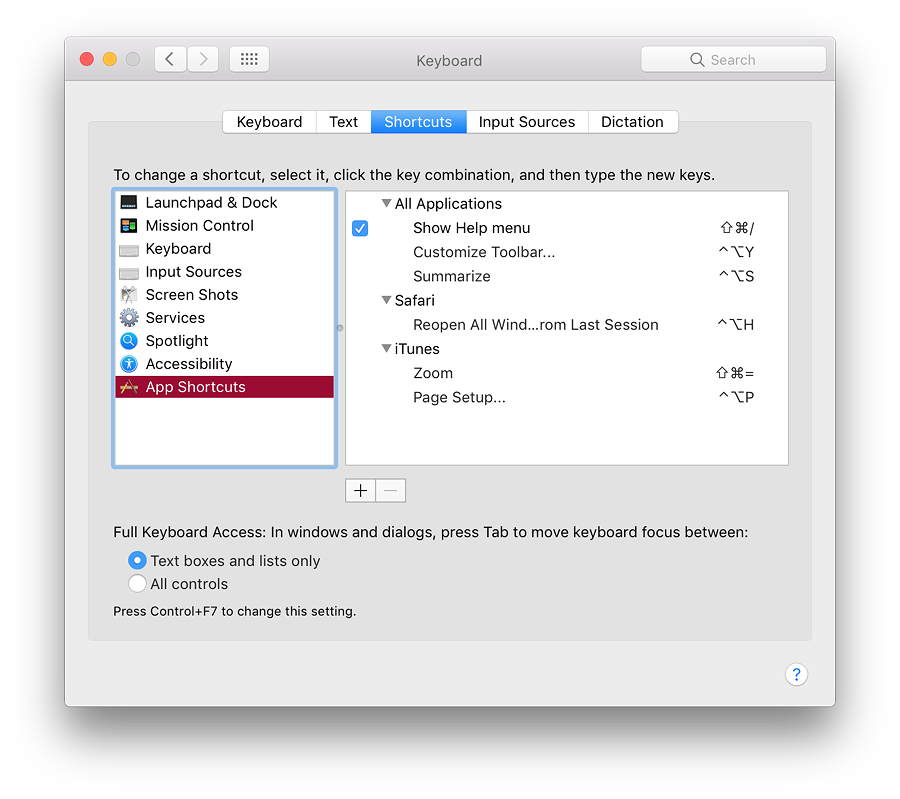
With "Text boxes and lists only" the focus is only where we may enter text (such as Search boxes or address fields in Safari). "With All controls" the focus cycles round text windows and other controls like buttons, sliders (and bookmark entries in Safari). Text beneath reads, "Press Control + F7 to change this setting." For some setups this will require fn + Control + F7 to be used. When this is used the selected radio button is changed immediately.
Input SourcesAn OS X installation on a Mac allows a number of keyboard options. They may be selected in this panel. In past versions of OS X this was in the Language & Text Preferences panel (See Language & Region). Not only has it been moved, but it had a complete redesign in Mavericks. It is mainly unchanged since then, although some icons have been updated.
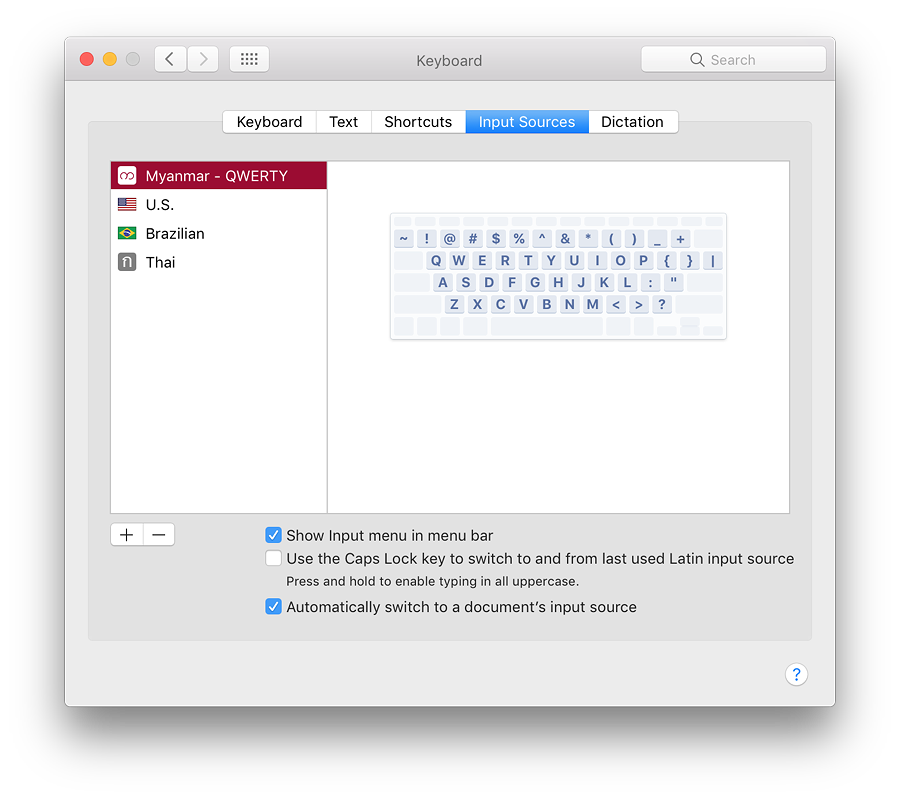
The default selection is the localised language: US English for computers in many areas. When only the default is selected there is no icon in the menu bar. We may add or remove keyboards by using the + or - at the bottom of the panel.
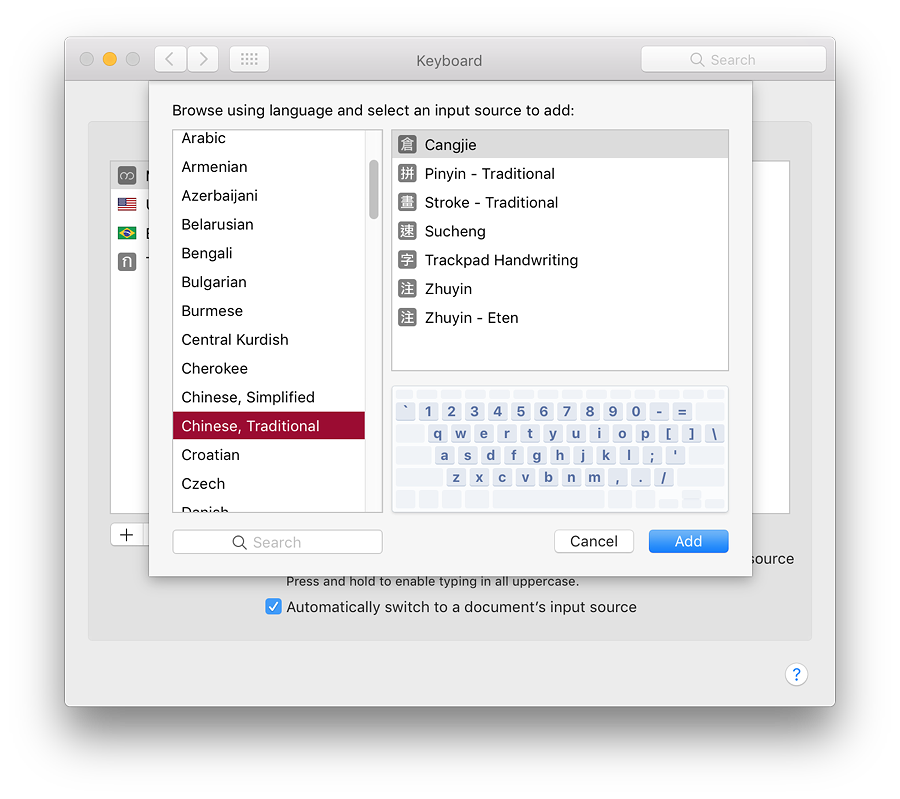
A change has been made in the keyboard icon and its display in the menubar. Several counties no longer have country flags: examples include Greek, Myanmar and Thailand. However some regional keyboards (e.g. Hawaiian) show flags. There is a search box at the bottom of the panel to speed things up. A keyboard already selected and in use is greyed out in the input source panel. Currently, "Others" only displays a keyboard marked Unicode Hex Input as before. Any input source is included to the list of those in use by pressing the Add button.
DictationIn versions of OS X there was a separate Dictation preferences panel. This was in two parts: Dictation; and Text to Speech. Dictation is now in the Keyboard preferences, while Text to Speech has been moved to Accessibility in the Speech section. A separate Dictation section in Accessibility controls the way users enter commands by speech and control the functions of the computer. This works in tandem with Dictation in Keyboard preferences and seems to have been a move that might cause some confusion.The Dictation feature can be used in any application where typing is normally required, although there are limits to output. On the left side of the panel is a microphone icon (updated from before). This indicates input levels in white and dark grey. As the sound increases, the white rises. Below this icon, the currently selected input method is shown, for example, "Internal Microphone." Clicking on this reveals a small menu. By default, it is set to Automatic which uses the most suitable input method. This menu will change if other devices are connected to the computer.
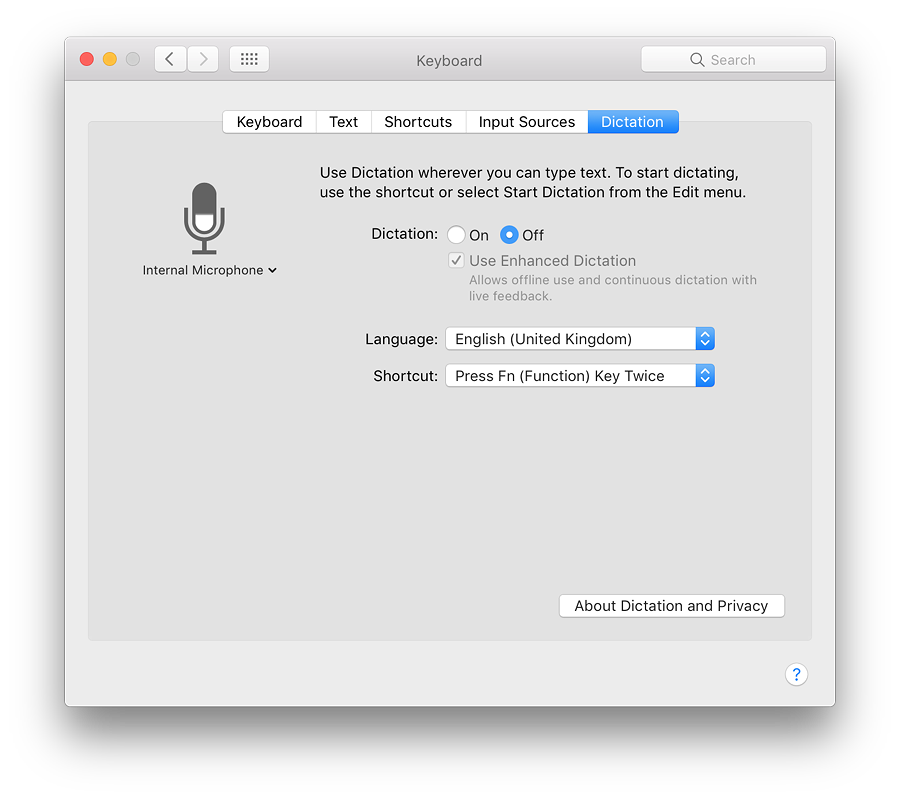
When Dictation is turned On, a microphone icon appears in the menubar. When pressed this shows a short menu:
Results may vary with user input. While I had better success by changing Siri to a UK English voice on the iPhone, selecting "English (United Kingdom) did not provide the accuracy I wanted until I turned on Enhanced Dictation. Pressing the Shortcut button reveals a small menu with a number of options for starting Dictation. Keys that may be specified include Fn (on some computers) and Command keys. In the menu revealed by the button, shortcuts may also be turned Off, or a user may select Customize: a text box appears for the user's own choice(s) to be entered. Not all key combinations will be accepted. Using Customize, I was able to use the F6 key (F11 and F12 were already allocated). If a key or combination cannot work as a shortcut, instead of a warning triangle as before, the feature (e.g. Volume) is shown. If a Shortcut is deselected, Dictation may be started by an item in the Edit menu of suitable applications. Changing the key combination settings in the Dictation pane changes the entry in the Edit menu item of applications immediately.
However, when Enhanced Dictation was selected, a download of almost 500MB took place and the text was then changed to remove mention of the download. There were a number of improvements. When I tried the microphone, I was first asked to confirm the language. Adding another language later, needed that to be downloaded. The download of the Thai package was some 714 MB. The microphone icon is now grey. Sound levels are indicated by white, as on the main panel. I was able to produce text output in each language I tried. When Enhanced Dictation was off, the feature worked in the limited way that it had before. A user may select another dictation language by clicking on the language shown on the microphone icon. There is a delay while the software is loaded.
As an additional note, using the Thai option, I was able to write quite effectively, although I am only able to speak street Thai. I cannot read or write the language, but using the dictation feature, I was able to produce some sentences which were correct. Used in conjunction with System Preferences > Accessibility, there are also several commands available to enable a user not only to dictate, but to correct, or enter system commands. The commands available in Accessibility may be deselected, or users may add their own commands At the bottom of the screen, is a button marked, "About Dictation and Privacy". This opens a panel which has a text explanation of the use of online access and the storage of data on remote servers.
See Also:
Graham K. Rogers teaches at the Faculty of Engineering, Mahidol University in Thailand. He wrote in the Bangkok Post, Database supplement on IT subjects. For the last seven years of Database he wrote a column on Apple and Macs. He is now continuing that in the Bangkok Post supplement, Life. He can be followed on Twitter (@extensions_th) |
|

For further information, e-mail to

|

|